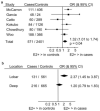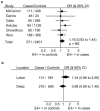Does apolipoprotein E genotype influence the risk of ischemic stroke, intracerebral hemorrhage, or subarachnoid hemorrhage? Systematic review and meta-analyses of 31 studies among 5961 cases and 17,965 controls
- PMID: 16385096
- PMCID: PMC2577180
- DOI: 10.1161/01.STR.0000199065.12908.62
Does apolipoprotein E genotype influence the risk of ischemic stroke, intracerebral hemorrhage, or subarachnoid hemorrhage? Systematic review and meta-analyses of 31 studies among 5961 cases and 17,965 controls
Abstract
Background and purpose: Apolipoprotein E genotype (APOE) is associated with cholesterol metabolism, ischemic heart disease, and cerebral amyloid angiopathy, and so may affect risk of both ischemic and hemorrhagic stroke.
Methods: We comprehensively sought and identified studies of the association of apoE with ischemic stroke (IS), intracerebral hemorrhage (ICH), and subarachnoid hemorrhage (SAH). We did meta-analyses to assess the evidence for an association between APOE and the various pathological types and subtypes of stroke, and assessed the effects of several methodological criteria.
Results: We analyzed data from 31 eligible studies (26 IS, 8 ICH, and 3 SAH) in 5961 cases and 17 965 controls. epsilon4 allele-containing (epsilon4+) genotypes were significantly associated with IS (odds ratio [OR], 1.11; 95% CI, 1.01 to 1.22) and SAH (OR, 1.42; 95% CI, 1.01 to 1.99) and nonsignificantly with ICH (OR, 1.16; 95% CI, 0.93 to 1.44), whereas epsilon2+ genotypes were associated with ICH (OR, 1.32; 95% CI, 1.01 to 1.74). Associations appeared stronger with epsilon4+ genotypes for large artery compared with other IS subtypes and for Asian compared with white populations, and with epsilon2+ genotypes for lobar compared with deep hemorrhages. However, we found no association between epsilon4+ genotypes and IS when we analyzed only larger studies (>200 cases; OR, 0.99; 95% CI, 0.88 to 1.11) or studies without control selection bias (OR, 0.99; 95% CI, 0.85 to 1.17).
Conclusions: Publication and selection biases make existing studies of APOE and stroke unreliable. Further, very large, methodologically rigorous studies are needed.
Figures





References
-
- Floßmann E, Schulz UGR, Rothwell PM. Systematic review of methods and results of studies of the genetic epidemiology of ischemic stroke. Stroke. 2004;35:212–227. - PubMed
-
- Woo D, Sauerbeck LR, Kissela BM, Khoury JC, Szaflarski JP, Gebel J, Shukla R, Pancioli AM, Jauch EC, Menon AG, Deka R, Carrozzella JA, Moomaw CJ, Fontaine RN, Broderick JP. Genetic and environmental risk factors for intracerebral hemorrhage. Preliminary results of a population-based study. Stroke. 2002;33:1190–1196. - PubMed
-
- van Gijn J, Rinkel GJE. Subarachnoid hemorrhage: diagnosis, causes and management. Brain. 2001;124:249–278. - PubMed
-
- Kissela BM, Sauerbeck L, Woo D, Khoury J, Carrozzella J, Pancioli A, Jauch E, Moomaw CJ, Shukla R, Gebel J, Fontaine R, Broderick J. Subarachnoid hemorrhage. A preventable disease with a heritable component. Stroke. 2002;33:1321–1326. - PubMed
-
- Schulz UGR, Flossmann E, Rothwell PM. Heritability of ischemic stroke in relation to age, vascular risk factors, and subtypes of incident stroke in population-based studies. Stroke. 2004;35:819–824. - PubMed
Publication types
MeSH terms
Substances
Grants and funding
LinkOut - more resources
Full Text Sources
Medical
Miscellaneous

